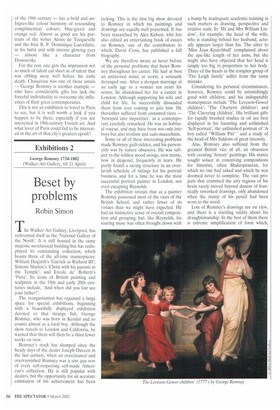Beset by problems
Robin Simon
The Walker Art Gallery, Liverpool, has reinvented itself as the National Gallery of the North'. It is still housed in the same majestic neoclassical building but has redisplayed its outstanding collection, which boasts three of the all-time masterpieces: William Hogarth's 'Garrick as Richard III% Simone Martini's 'Christ with his parents in the Temple'; and Ercole de' Roberti's 'Pieta'. Its icons of British painting and sculpture in the 19th and early 20th centuries include, 'And when did you last see your father?'.
The reorganisation has regained a large space for special exhibitions, beginning with a beautifully displayed exhibition devoted to that strange fish, George Romney, who was born in Kendal and so counts almost as a local boy. Although the show travels to London and California, be warned that there will then be a third fewer works on view.
Romney's stock has slumped since the heady days of the dealer Joseph Duveen in the last century, when an overcleaned and overvarnished Romney was a sine qua non of every self-respecting self-made American's collection. He is still popular with dealers, but the opportunity for an accurate estimation of his achievement has been
lacking. This is the first big show devoted to Romney in which his paintings and drawings are equally well presented. It has been researched by Alex Kidson, who has also edited an entertaining book of essays on Romney, one of the contributors to which, David Cross, has published a full biography.
We are therefore aware as never before of the personal problems that beset Romney throughout his career. He had at best an untutored mind; at worst, a seriously deranged one. After a shotgun marriage at an early age to a woman ten years his senior, he abandoned her for a career in London. Although supporting his wife and child for life, he successfully dissuaded them from ever coming to join him. He thereafter suffered from unnamed vices — 'betrayed into impurities', as a contemporary carefully remarked. He was an habitual voyeur, and may have been not only into boys but also troilism and sado-masochism.
Some or all of these interesting problems made Romney guilt-ridden, and his personality was by nature obsessive. He was subject to the wildest mood swings, now manic, now in despond, frequently in tears. He partly found a saving structure in an overlavish schedule of sittings for his portrait business, and for a time he was the most successful portrait painter in London, not even excepting Reynolds.
The exhibition reveals that as a painter Romney possessed most of the vices of the British School, and rather fewer of its virtues than we might have expected. He had an instinctive sense of overall composition and grouping, but, like Reynolds, his soaring muse was often brought down with a bump by inadequate academic training in such matters as drawing, perspective and relative scale. In `Mr and Mrs William Lindow', for example, the head of the wife, who is standing behind her husband, actually appears larger than his. The sitter to 'Miss Joan Knatchbull' complained about the ape-like length of her arms, but she might also have objected that her head is simply too big in proportion to her body. Three of the heads in the complex group of 'The Leigh family' suffer from the same mistake.
Considering his personal circumstances, however, Romney could be astonishingly good with children, and his indisputable masterpieces include 'The Leveson-Gower children'; 'The Charteris children'; and The Clavering children'. His brilliant gifts for rapidly brushed studies in oil are best displayed in his haunting and unfinished 'Self-portrait', the unfinished portrait of 'A boy called "William Pitt"' and a study of the head of Mrs Siddons of great intensity.
Alas, Romney also suffered from the greatest British vice of all, an obsession with creating 'history' paintings. His mania sought solace in conceiving compositions for histories, often Shakespearean, for which no one had asked and which he was doomed never to complete. The vast projects that crammed the airy regions of his brain rarely moved beyond dozens of frantically reworked drawings, only abandoned when the stump of his pencil had been worn to the wood.
Lots of Romney's drawings are on view, and there is a startling oddity about his draughtsmanship. In the best of them there is extreme simplification of form which, together with a passing resemblance to the dotty dreams of Blake and the nightmares of Fuseli, lends his work a deceptive appearance of 'modernity'. I have a sneaking feeling that they will win him legions of new admirers, and for all the wrong reasons.
George Romney 1734-1802, Walker Art Gallery, Liverpool, until 21 April; at the National Portrait Gallery, London, 30 May to 18 August; Huntington Library, San Marino, California, 15 September to 1 December.















































































 Previous page
Previous page